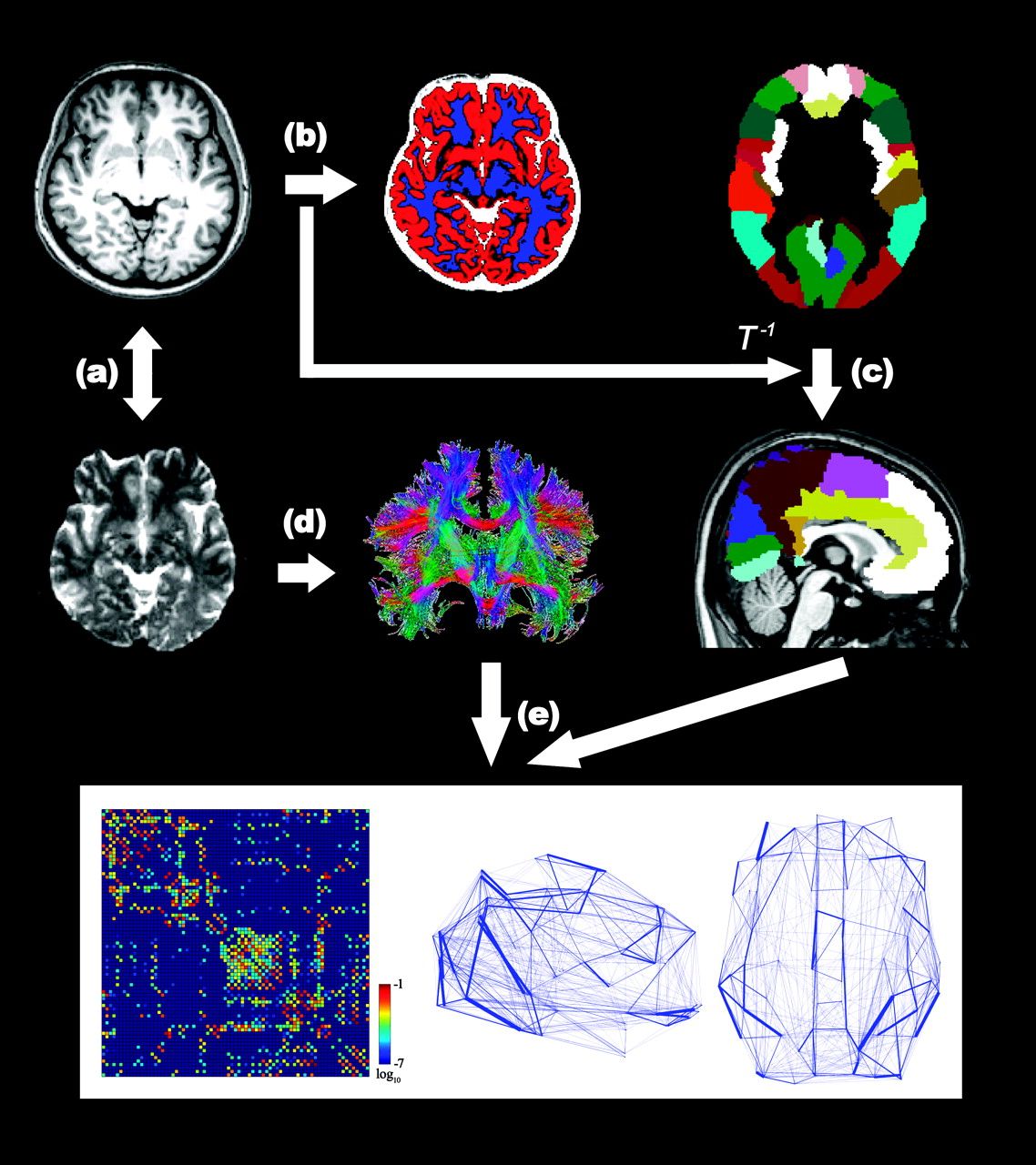My longtime friend and mentor Dr. Karl Pribram has often said to me that anything may be found in the brain. It seems that whatever the current trend is – hydraulics or computers, chaos theory or graph theory – some structure or function in the brain supports the idea in some way. It’s only a matter of time when quantum and/or optical hybrid computing machines are common and a larger audience will understand and perhaps embrace Karl’s holonomic hypothesis.

Figure 1. The construction of a cortical anatomical network by diffusion tensor imaging. See text below for more information. From “Sex- and Brain Size–Related Small-World Structural Cortical Networks in Young Adults: A DTI Tractography Study“. By Chaogan Yan, Gaolang Gong, Jinhui Wang, Deyi Wang, Dongqiang Liu, Chaozhe Zhu, Zhang J. Chen, Alan Evans, Yufeng Zang and Yong He. Cerebral Cortex Volume 21, Number 2, February 2011.
A currently popular topic is graph theory, which is certainly dear to my heart as core to Semantic Web technologies and forms the mathematical foundation of many other networking technologies and analyses. Naturally, graph theory is currently being used while investigating many different things including the central nervous system.
The authors of the new paper “Sex- and Brain Size–Related Small-World Structural Cortical Networks in Young Adults: A DTI Tractography Study” (published February 2011 in Cerebral Cortex) hypothesized that there are sex and brain size related differences in the patterns of anatomical connectivity in the human brain. To test their hypothesis, the research team used diffusion tensor imaging (DTI) techniques on 72 healthy young human adults to construct interregional connectivity for each participant and calculate topological parameters using graph-theoretical approaches. They then investigated the association of interregional connectivity and topological parameters with sex and brain size.
The research team derived the cerebral cortical network connectivity of each individual using a multi-stepped process, which is outlined visually in Figure 1 above. The structural image of a brain was first transformed into what is called diffusion tensor imaging native space (a). Next the image was segmented into grey matter, white matter, and cerebrospinal fluid (b; left image). The automated anatomical labeling template (b; right image) was applied to an individual’s segmented diffusion tensor imaging native space brain image (c). In parallel, each individual’s white matter fibers were reconstructed in the whole brain by using diffusion tensor imaging deterministic tractography (d).
The result is a brain mapped into 39 cerebral cortical regions within each hemisphere and associated with a connection matrix weighted according to the number of fibers connecting the regions. At bottom (e) left is a connection matrix color coded for the fiber density between each pair of regions. At bottom middle and right are views of the brain showing connections as graphs with nodes placed at the center of mass for each of the 39 brain regions per hemisphere. Edge thicknesses are coded according to the number of fibers connecting the regions.
Consistent with previous studies, the research team found that women’s brains were significantly smaller than those of men. The team found that the difference in brain size between males and females remained after correcting for height. Unfortunately, they didn’t report if the difference remains significant after correcting for overall body mass. Also consistent with previous research results is their finding that the anatomical networks of the human brain have “small-world network” characteristics with relatively greater local interconnectivity and an emphasis on the shorter connections between regions.
This study goes beyond earlier studies by showing that females have greater local clustering in cortical anatomical networks as compared with males, suggesting higher local network efficiency in the female brain. They also found that brain size is significantly and negatively correlated with local clustering, suggesting that smaller human brains are more efficient in local information transfer. Interestingly, they found that the brain size effect on local efficiency was not significant in males.
The brain is like many things. Probably because the brain is really completely unlike anything humans have ever built or understood. Put another way, Newtonian physics is an approximation (it’s “like”) relativity physics within a particular scale of time and space. The brain encompasses so much structural and functional complexity that there are a lot of things “like” in the brain. It is fun and sometimes even useful to say that a certain system in the brain is like a telephone switchboard, a computer, or a social network. However, we must keep in mind that the brain is really not the same as anything else we know.
Pingback: Tweets that mention Sex Matters But the Brain is Like Nothing Else | Dr. Donald Doherty's Blog -- Topsy.com
Pingback: Extending Our Capabilities Through Automated Knowledge Acquisition | Dr. Donald Doherty's Blog